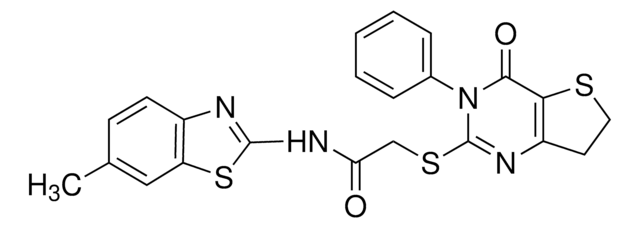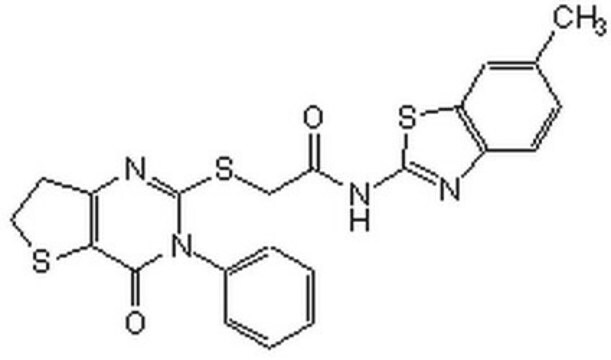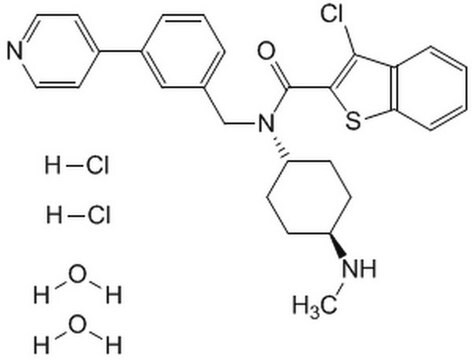361559
GSK-3 Inhibitor XVI
GSK-3 Inhibitor XVI - CAS 252917-06-9, is a cell-permeable, potent, ATP-competitive, and highly selective GSK-3 inhibitor (IC₅₀ = 10 and 6.7 nM against GSK-3α and GSK-3β, respectively).
Synonyme(s) :
GSK-3 Inhibitor XVI, 6-(2-(4-(2,4-Dichlorophenyl)-5-(4-methyl-1H-imidazol-2-yl)-pyrimidin-2-ylamino)ethyl-amino)-nicotinonitrile, CHIR99021
About This Item
Produits recommandés
Niveau de qualité
Essai
≥97% (HPLC)
Forme
solid
Fabricant/nom de marque
Calbiochem®
Conditions de stockage
OK to freeze
protect from light
Couleur
light beige
Solubilité
DMSO: 5 mg/mL
Conditions d'expédition
ambient
Température de stockage
2-8°C
Chaîne SMILES
Clc1c(ccc(c1)Cl)c2nc(ncc2c4[nH]cc(n4)C)NCCNc3ncc(cc3)C#N
InChI
1S/C22H18Cl2N8/c1-13-10-29-21(31-13)17-12-30-22(32-20(17)16-4-3-15(23)8-18(16)24)27-7-6-26-19-5-2-14(9-25)11-28-19/h2-5,8,10-12H,6-7H2,1H3,(H,26,28)(H,29,31)(H,27,30,32)
Clé InChI
AQGNHMOJWBZFQQ-UHFFFAOYSA-N
Description générale
Conditionnement
Avertissement
Reconstitution
Autres remarques
Ring, D.B., et al. 2003. Diabetes52, 588.
Bennett, C.N., et al. 2002. J. Biol. Chem.277, 30998.
Cline, G.W., et al. 2002. Diabetes51, 2903.
Informations légales
Mention d'avertissement
Warning
Mentions de danger
Conseils de prudence
Classification des risques
Acute Tox. 4 Oral
Code de la classe de stockage
11 - Combustible Solids
Classe de danger pour l'eau (WGK)
WGK 3
Point d'éclair (°F)
No data available
Point d'éclair (°C)
No data available
Certificats d'analyse (COA)
Recherchez un Certificats d'analyse (COA) en saisissant le numéro de lot du produit. Les numéros de lot figurent sur l'étiquette du produit après les mots "Lot" ou "Batch".
Déjà en possession de ce produit ?
Retrouvez la documentation relative aux produits que vous avez récemment achetés dans la Bibliothèque de documents.
Les clients ont également consulté
Notre équipe de scientifiques dispose d'une expérience dans tous les secteurs de la recherche, notamment en sciences de la vie, science des matériaux, synthèse chimique, chromatographie, analyse et dans de nombreux autres domaines..
Contacter notre Service technique









